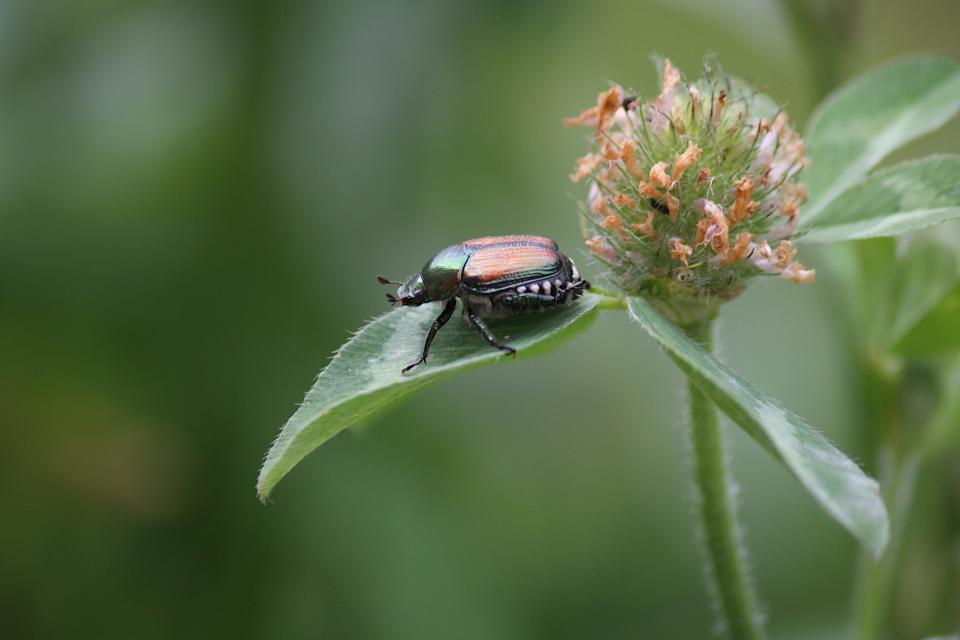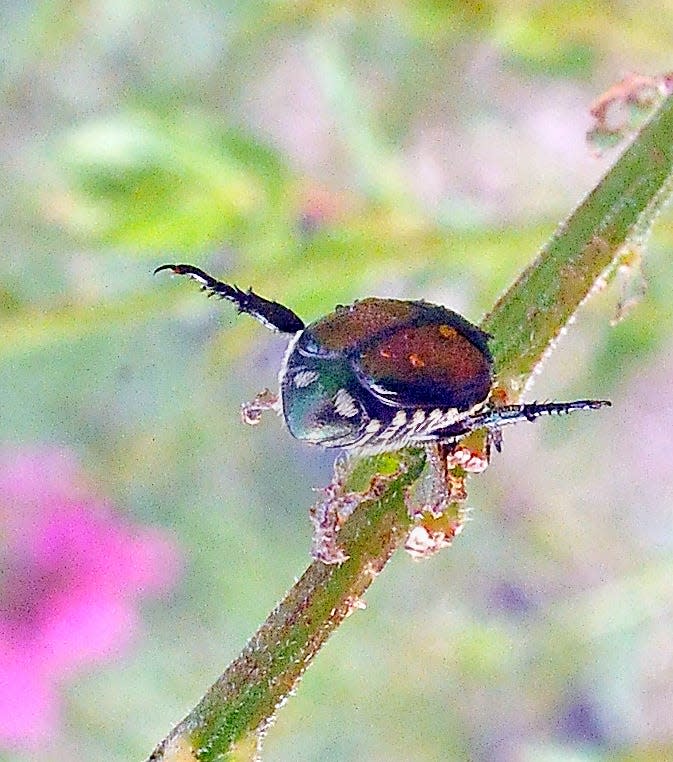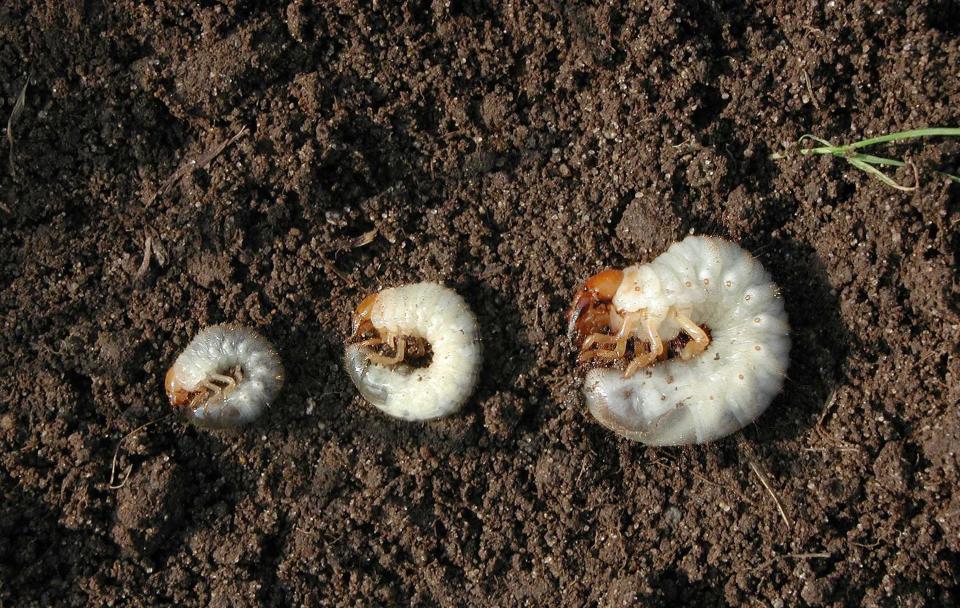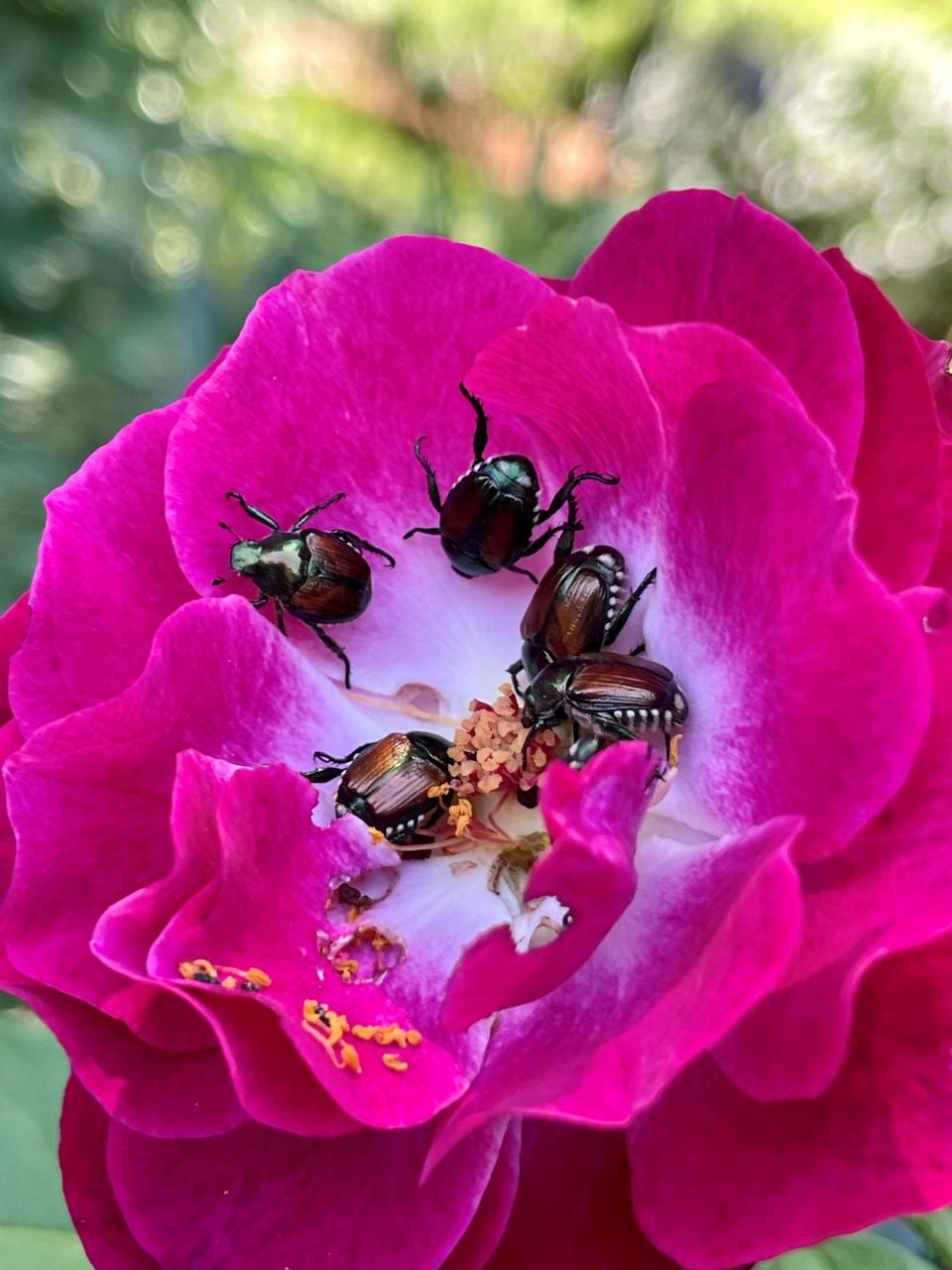Foreign invaders: Japanese Beetles now laying eggs for next wave of march across country
Millions of metallic green invaders adorned with brown wing covers have been marching over the foliage across Ohio this summer like columns of tanks pillaging a foreign land.
"Japanese Beetles feed on more than 300 different species of plants," explained Dr. Cindy Perkovich, an entomologist at Ashland University. "They munch on just about anything."
They're ruthless, too, eating only the leaf tissue and leaving behind the veins as plant skeletons that quickly wither and die.
As larvae, the invaders eat entire root systems, shriveling lawns and flowerbeds to a dried brown.
"They're pretty tenacious," Perkovich said. "They demolish a lot of things."
'They have no enemies here'
The battle against Japanese Beetles has entered its 107th annual campaign in North America.
Before that, the pesky critters lived safely across the ocean.
"They were brought here," Perkovich explained. "The Japanese brought them into the country during the World's Fair."

It was 1916 and gardeners from Japan, eager to impress their foreign friends, brought the most glorious of their exotic plants to the United States.
Scientists suspect that the species' grubs − their proper name is Popillia japonica − were hidden in the dirt around the plants' young root systems.
It didn't take long for the larvae to become pupae and then adults. The flew from the World's Fair, found a tasty landing spot, and flourished.
Their first established population in North America was discovered at a nursery in New Jersey.
By 1972, Japanese Beetles had heavily infested 22 states east of the Mississippi River.
"They have no enemies here," Perkovich said.
Grubs begin turning lawns brown in late summer
The beetles lay their eggs in August. The eggs are white ovals, usually about 1/16 inch (1.5 mm) long and 3/64 inch (1.0 mm) wide, according to a fact sheet prepared by The Ohio State University.
Females lay up to 60 eggs throughout the summer, from two to four inches deep in the soil. Even after mating season has ended, adults live the rest of autumn until the first frost.
Egg development takes anywhere from just longer than a week to nearly a month. Once they emerge, the grubs feed on roots and other organic material the rest of the year as they continue to grow.
"You'll see brown patches in lawns," Perkovich said.

By winter, the grubs have burrowed about eight inches deep where they can surive until spring. The larvae return to the surface in mid April, pupate, and emerge as adults in June.
"They're really active for about two months," Perkovich said of the adults.
The new generation then lays its eggs in August, continuing the cycle of the Japanese Beetle invasion.
'You're actually creating a problem'
Attempts at controlling Japanese Beetle populations can be very expensive, according to the U.S. Dept. of Agriculture.
The federal government's primary objective is to limit the spread of the beetles out west.
East of the Mississippi, the most common attempt at controlling Japanese Beetles is the deployment of bag lures.
Those traps use pheromones to attract the beetles, which slip into the bag and cannot escape. The only issue that biologists have with that method is that it draws in the insects from an unnatural distance.

"If you don't have a problem and you put a lure out, you're actually calling them into your area," Perkovich said.
The newcomers are likely to stop for a few moments and lay eggs before venturing into the trap, causing a large population of grubs to emerge that autumn and adults to fly from the ground the next spring.
The traps could become filled, but not before the adults deposit thousands of eggs.
"So, you're actually creating a problem," Perkovich said.
'Get the female before she lays her eggs'
Commercial growers, often nurseries that grow ornamental of fruit trees, often look to chemicals to solve the issue.
Those chemicals are either spread onto the ground or sprayed on to the leaves of plants the farmers hope to protect. Both methods kill the grubs and adults of Japanese Beetles after ingestion.
The USDA warns that chemicals meant to control the invasive species also may harm beneficial members of the ecosystem.
"We have to figure out how to live with them in peace," Perkovich said.
The most promising method of controlling the Japanese Beetle populations has been through the assistance of the spring Tiphia, a small parasitic wasp that attacks the beetles while they are still grubs. Biologists started introducing the wasps in the United States about 10 years ago, and, so far, their populations are slowly growing.

Waiting for a biological predator to emerge in Ohio might seem like a hopeless task to those who find their favorite plants destroyed by Japanese Beetles, but Perkovich said we aren't completely powerless without the use of chemicals.
She has been a predator of the insects herself every summer since she was a little girl.
"I love to garden, so I deal with Japanese Beetles all the time," Perkovich said.
Her weapon is a bucket filled with soapy water. Every time she finds an adult Japanese Beetle, she tosses it into her bucket to drown.
"Hopefully you can get the female before she lays her eggs," Perkovich said. "If you do, then next year you won't have as many grubs."
ztuggle@gannett.com
419-564-3508
Twitter: @zachtuggle
This article originally appeared on Mansfield News Journal: Japanese Beetles laying eggs for next wave of invasion across country

